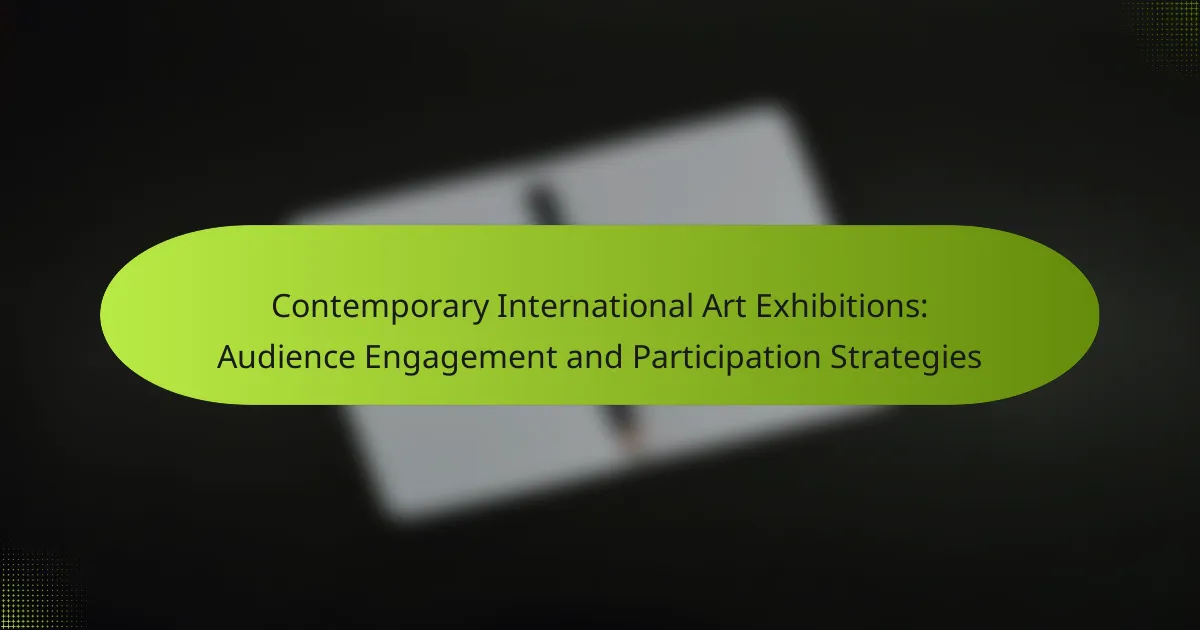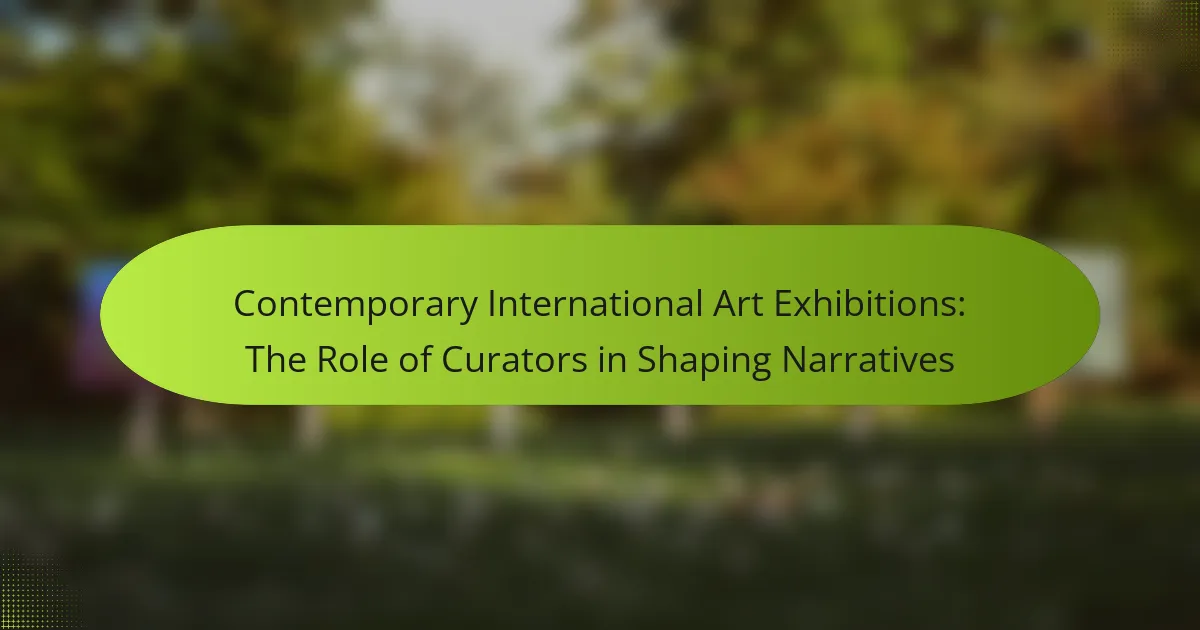Contemporary international art exhibitions are addressing environmental sustainability by integrating eco-friendly materials and promoting awareness of climate issues. These exhibitions showcase installations made from recycled materials, engage audiences through educational programs, and leverage digital art to minimize resource consumption. However, challenges such as high resource use and funding limitations persist. Emerging trends emphasize community involvement and carbon offsetting strategies, shaping a more sustainable future for artistic expression.
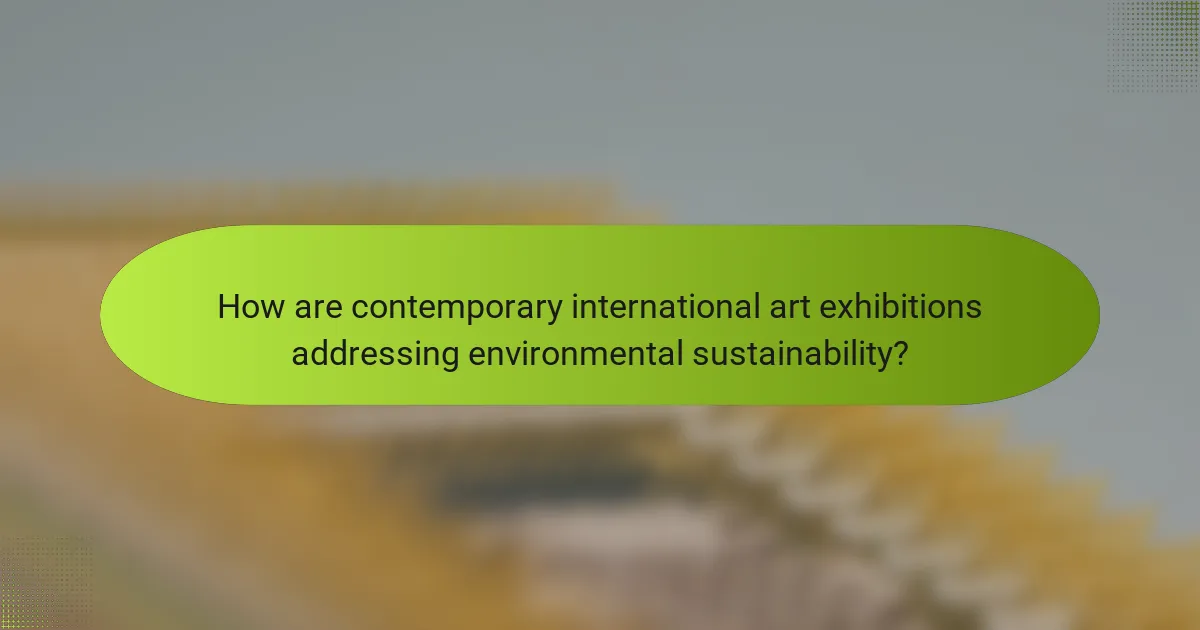
How are contemporary international art exhibitions addressing environmental sustainability?
Contemporary international art exhibitions are increasingly integrating environmental sustainability into their practices. Artists and curators are using eco-friendly materials, promoting awareness, and addressing climate issues through their works.
Many exhibitions now feature installations made from recycled or sustainable materials, reducing waste and environmental impact. For example, the Venice Biennale has highlighted artists who focus on ecological themes, fostering dialogue on sustainability.
Additionally, these exhibitions often include educational programs that engage the public on environmental issues, encouraging action and awareness. The use of digital art forms also minimizes physical resource consumption, aligning with sustainable practices.
Overall, contemporary art exhibitions are evolving to reflect a commitment to environmental sustainability, shaping the future of artistic expression.
What innovative practices are being adopted by artists to promote sustainability?
Artists are adopting innovative practices to promote sustainability through eco-friendly materials and community engagement. Many use recycled or biodegradable materials, reducing environmental impact. Collaborations with local communities foster awareness and support for sustainable initiatives. Additionally, digital art reduces physical resources, while immersive installations highlight environmental issues. These practices reflect a commitment to sustainability in contemporary art.
Which international art exhibitions are leading the way in sustainable art practices?
Leading international art exhibitions in sustainable practices include the Venice Biennale, Art Basel, and Documenta. These events showcase innovative approaches to environmental issues through art.
The Venice Biennale emphasizes eco-friendly materials and themes, featuring artists who address climate change. Art Basel promotes sustainability through curated projects and partnerships with environmental organizations. Documenta, held in Kassel, Germany, frequently incorporates ecological concepts, encouraging dialogue on sustainability in contemporary art.
These exhibitions set benchmarks for integrating sustainability into the art world, influencing artists and institutions globally. They highlight the role of art in advocating for environmental awareness and action.
What role do curators play in enhancing sustainability in art exhibitions?
Curators play a vital role in enhancing sustainability in art exhibitions by implementing eco-friendly practices. They select materials and artworks that minimize environmental impact, promote awareness of sustainability issues, and engage artists in creating works that reflect ecological concerns. Curators also facilitate partnerships with organizations focused on sustainability, thereby amplifying the message of environmental responsibility within the art community. By prioritizing sustainable practices, they contribute to a cultural shift towards more responsible consumption and production in the art world.
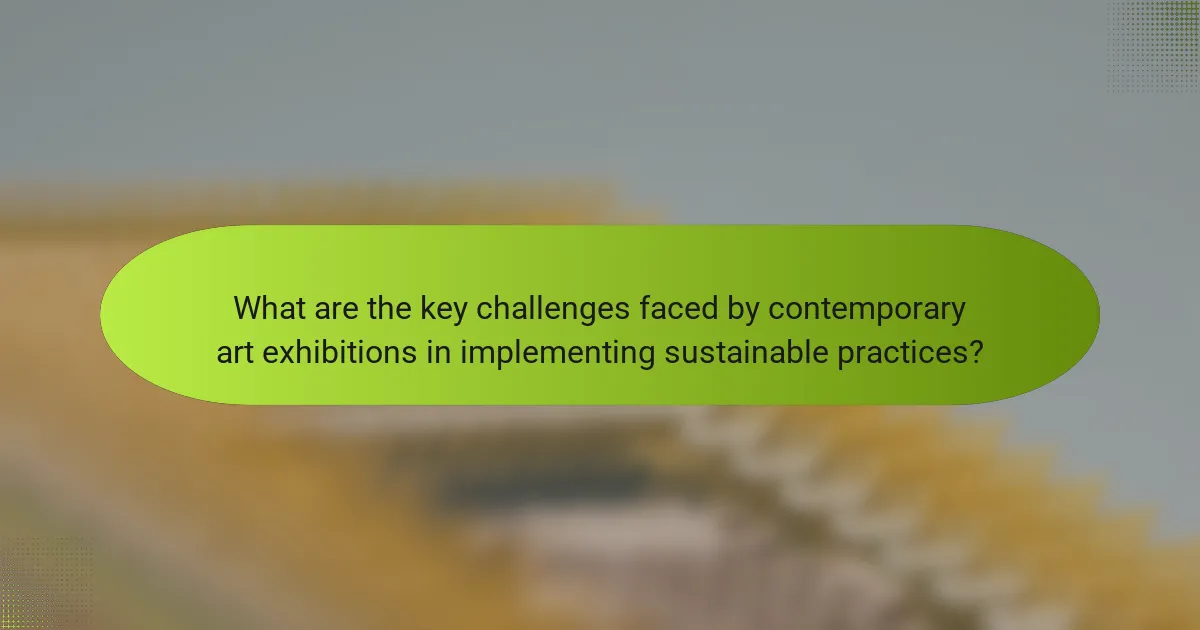
What are the key challenges faced by contemporary art exhibitions in implementing sustainable practices?
Contemporary art exhibitions face significant challenges in implementing sustainable practices. Key issues include high resource consumption, waste management difficulties, limited funding for green initiatives, and a lack of awareness among stakeholders. Additionally, the transient nature of exhibitions complicates long-term sustainability efforts.
How do financial constraints impact the sustainability efforts of art exhibitions?
Financial constraints significantly hinder sustainability efforts in contemporary international art exhibitions. Limited budgets restrict the adoption of eco-friendly materials and practices. Exhibitions may opt for cheaper, less sustainable options to cut costs, impacting their environmental footprint. As a result, the commitment to sustainability often becomes secondary to financial viability, undermining the potential for meaningful environmental initiatives.
What logistical issues arise when integrating sustainability into exhibition planning?
Integrating sustainability into exhibition planning presents logistical challenges such as resource allocation, supply chain management, and waste reduction. These issues require careful coordination to ensure eco-friendly practices are effectively implemented.
Resource allocation involves balancing budget constraints with sustainable materials and services. Supply chain management must prioritize eco-conscious vendors and transportation methods. Waste reduction strategies need to be established to minimize environmental impact during setup and dismantling.
Additionally, stakeholder engagement is crucial for fostering a shared commitment to sustainability. This collaboration can enhance the overall effectiveness of sustainable initiatives in contemporary art exhibitions.
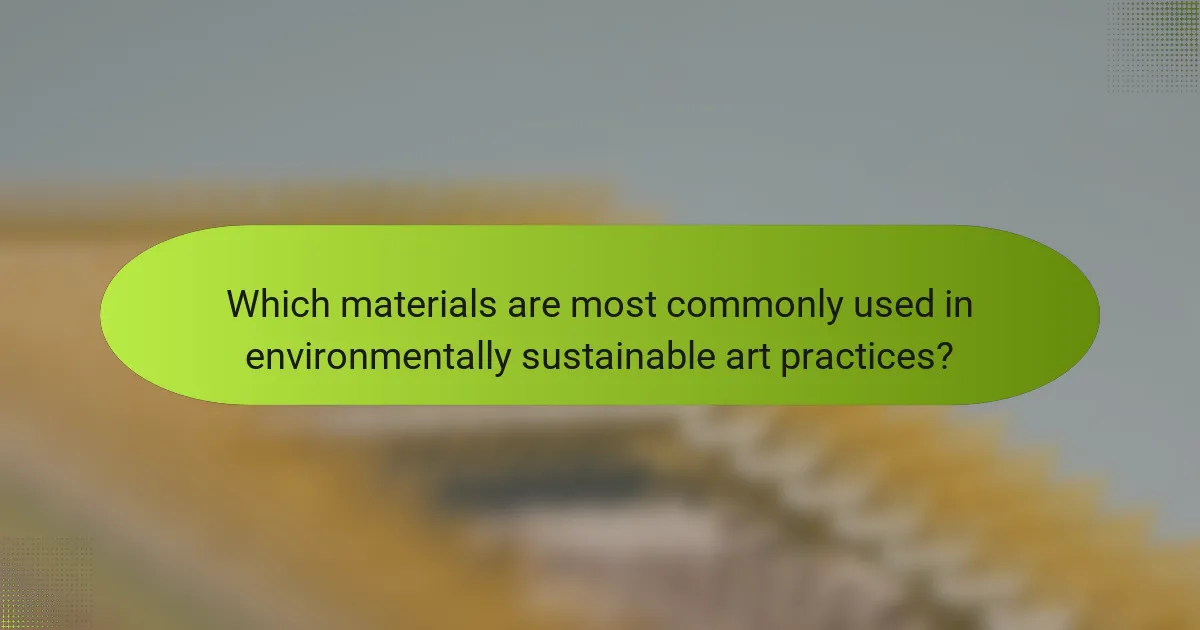
Which materials are most commonly used in environmentally sustainable art practices?
Commonly used materials in environmentally sustainable art practices include recycled paper, organic paints, natural fibres, reclaimed wood, biodegradable plastics, and upcycled metals. These materials minimize environmental impact while promoting creativity. For example, organic paints reduce harmful chemicals, and reclaimed wood adds unique character to artworks.
How do traditional vs. sustainable materials compare in contemporary art?
Sustainable materials often outperform traditional materials in contemporary art by offering lower environmental impact and promoting ecological awareness. Traditional materials, such as oil paints and plastics, contribute to pollution and resource depletion. In contrast, sustainable options like recycled paper and biodegradable substances minimize waste and encourage responsible sourcing.
Sustainable materials can enhance the aesthetic appeal of artworks by introducing unique textures and organic qualities, which are increasingly valued in the art community. For instance, artists using reclaimed wood or natural dyes create pieces that tell stories of environmental stewardship.
Additionally, the use of sustainable materials in art practices can lead to innovative techniques and concepts, pushing the boundaries of creativity. This shift reflects a growing awareness of climate change and the role of art in advocating for sustainability.
In summary, the comparison highlights that sustainable materials not only align with contemporary values but also offer unique artistic possibilities, making them increasingly favoured in international art exhibitions.
What are the benefits of using recycled materials in art exhibitions?
Using recycled materials in art exhibitions promotes environmental sustainability, reduces waste, and inspires creativity. Artists often transform discarded items into innovative works, showcasing the potential of repurposed materials. This practice encourages audience engagement by highlighting ecological issues and fostering a sense of community responsibility. Additionally, recycled art can lower exhibition costs while supporting local economies through the use of accessible materials.
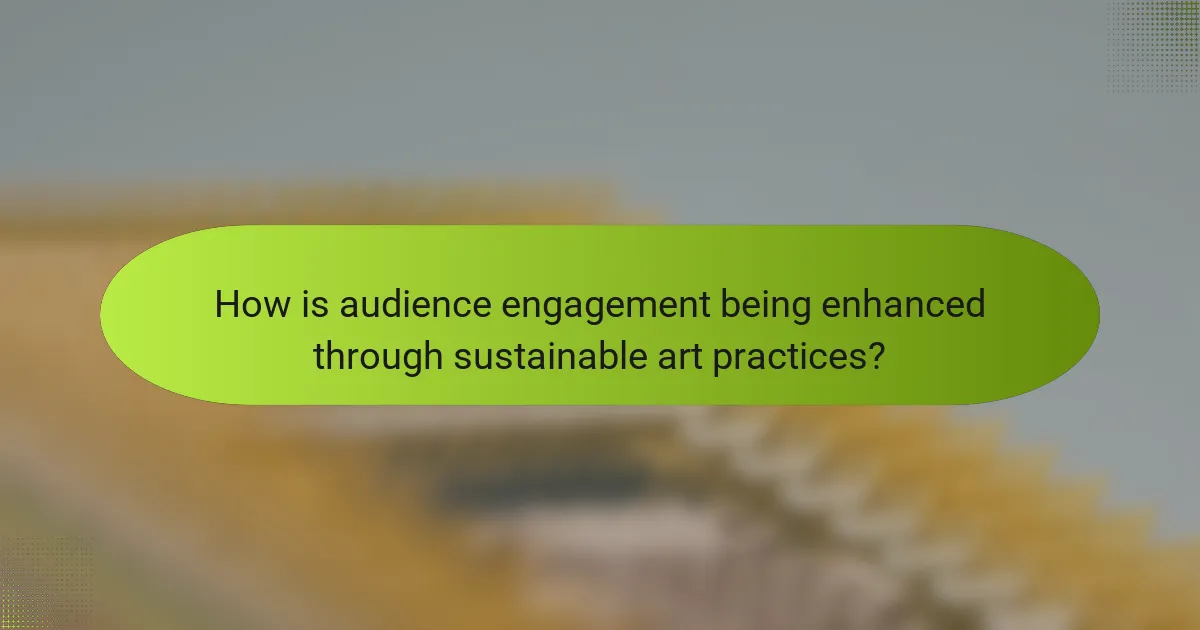
How is audience engagement being enhanced through sustainable art practices?
Sustainable art practices enhance audience engagement by fostering community involvement and environmental awareness. Artists create immersive experiences that invite participation, encouraging viewers to reflect on ecological issues. Collaborative projects often utilize recycled materials, making art accessible and relatable. As a result, audiences develop a deeper connection to both the art and the environment.
What educational programs are being implemented to raise awareness about sustainability in art?
Educational programs raising awareness about sustainability in art include workshops, seminars, and collaborative projects. These initiatives engage artists and audiences in eco-friendly practices and sustainable materials. For example, the “Art and Ecology” program at various international exhibitions promotes discussions on environmental impact. Additionally, initiatives like “Sustainable Art Practices” encourage artists to integrate sustainability into their creative processes.
How can interactive installations promote sustainability in art exhibitions?
Interactive installations can significantly promote sustainability in art exhibitions by engaging audiences and fostering environmental awareness. These installations often utilize recycled materials and energy-efficient technologies, demonstrating eco-friendly practices in art. For instance, artists might create immersive experiences that highlight climate change effects, prompting visitors to reflect on their ecological footprint. By integrating real-time data on resource consumption, installations can educate attendees about sustainable practices. Additionally, interactive elements encourage collaboration and community involvement, further amplifying the message of sustainability within contemporary art.
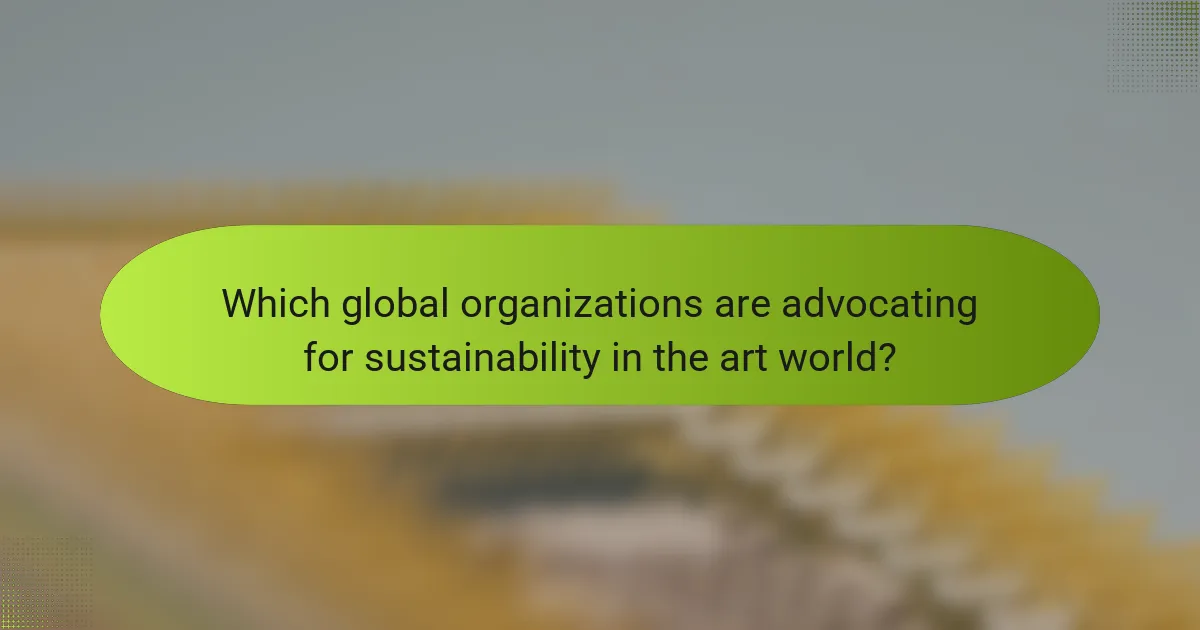
Which global organizations are advocating for sustainability in the art world?
Organizations advocating for sustainability in the art world include the Art for the Environment initiative, the Global Climate Action initiative, and the International Council of Museums. These groups promote eco-friendly practices and raise awareness about environmental issues through art. They focus on reducing waste, encouraging sustainable materials, and fostering collaborations between artists and environmentalists. Efforts are made to integrate sustainability into contemporary international art exhibitions, enhancing the dialogue between art and ecological consciousness.
What initiatives are being sponsored by these organizations to support sustainable art practices?
Organizations are sponsoring initiatives that promote sustainable art practices through various programs. These include funding eco-friendly materials for artists, supporting exhibitions that focus on environmental themes, and hosting workshops that educate artists about sustainability. Collaborative projects with environmental organizations aim to raise awareness and engage the public in sustainability issues. Additionally, some organizations are implementing carbon offset programs to reduce the environmental impact of art events. These efforts highlight the commitment to integrating sustainability into contemporary art exhibitions.
How do partnerships between artists and environmental organizations foster sustainability?
Partnerships between artists and environmental organizations enhance sustainability by integrating ecological themes into art. These collaborations promote awareness and inspire action regarding environmental issues. Artists leverage their creative platforms to engage audiences, while organizations provide expertise and resources for impactful projects. For example, large-scale installations often highlight climate change, fostering community dialogue. Such synergies not only elevate artistic practices but also contribute significantly to environmental advocacy efforts.
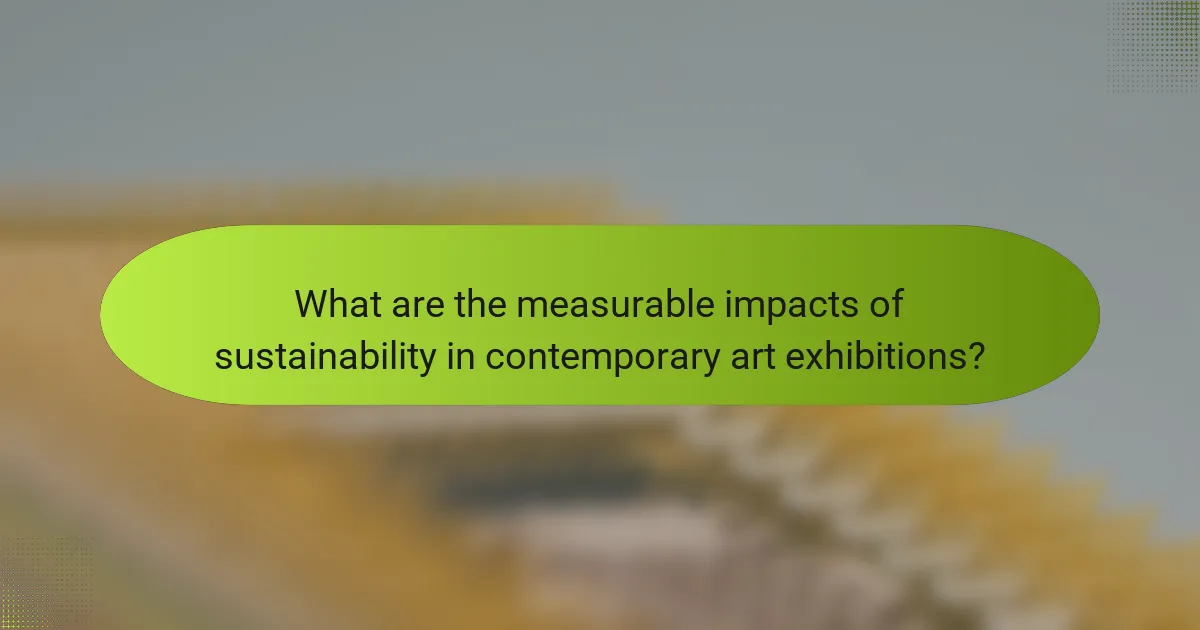
What are the measurable impacts of sustainability in contemporary art exhibitions?
Sustainability in contemporary art exhibitions significantly reduces environmental impact through resource efficiency and waste reduction. Many exhibitions now utilize sustainable materials, renewable energy, and eco-friendly practices. For instance, the use of recycled materials can decrease carbon footprints and promote circular economy principles. Additionally, measurable impacts include reduced energy consumption by up to 30% and waste diversion rates exceeding 50%. These initiatives not only enhance the aesthetic value of exhibitions but also engage audiences in environmental consciousness.
How can the carbon footprint of art exhibitions be assessed?
The carbon footprint of art exhibitions can be assessed through various methods. Key approaches include measuring energy consumption, transportation emissions, and material sourcing. Calculating the total greenhouse gas emissions from these factors provides a comprehensive view of environmental impact. Additionally, implementing carbon offset strategies can further mitigate the exhibition’s footprint.
What metrics are used to evaluate the success of sustainable practices in art?
Metrics used to evaluate the success of sustainable practices in art include carbon footprint reduction, resource efficiency, audience engagement, and waste management effectiveness. These metrics help assess the environmental impact and community involvement in contemporary international art exhibitions.
| Metric | Description |
|—————————-|————————————————|
| Carbon Footprint Reduction | Measures decrease in greenhouse gas emissions |
| Resource Efficiency | Evaluates the use of sustainable materials |
| Audience Engagement | Assesses public participation and awareness |
| Waste Management Effectiveness | Analyzes reduction and recycling of waste |
| Energy Consumption | Tracks energy usage from installations |
| Lifecycle Assessment | Evaluates environmental impact over time |
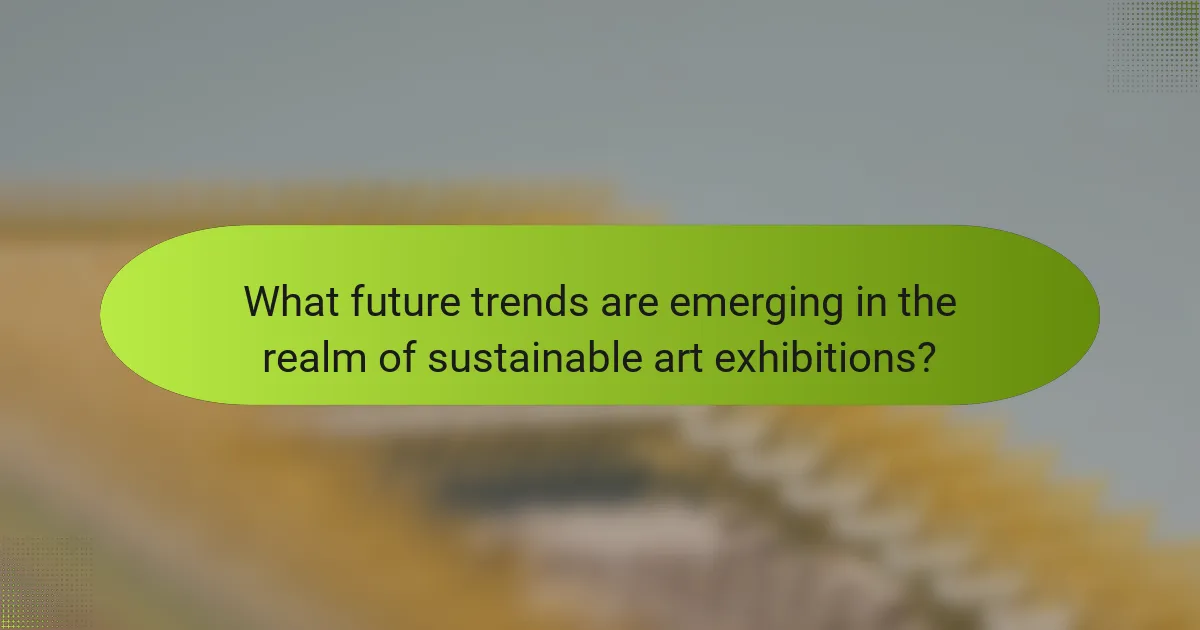
What future trends are emerging in the realm of sustainable art exhibitions?
Emerging trends in sustainable art exhibitions focus on eco-friendly practices and community engagement. Artists increasingly utilize recycled materials, reducing waste while promoting environmental awareness. Digital technologies enhance accessibility and limit physical resource use. Collaborative projects with local communities foster shared responsibility for sustainability. Additionally, exhibitions are adopting carbon offsetting strategies, ensuring a minimal environmental footprint.
How is technology shaping the future of sustainability in art practices?
Technology is significantly enhancing sustainability in art practices by enabling innovative materials and methods. Digital tools allow artists to create works that minimize waste and energy consumption. For instance, 3D printing and virtual reality reduce physical material use while expanding creative possibilities. Additionally, data-driven approaches help track environmental impact, fostering eco-conscious decision-making. Artists increasingly collaborate with tech companies to develop sustainable practices, integrating renewable resources and promoting awareness through their work. This synergy between technology and art is shaping a more sustainable future for the art community.
What role will virtual exhibitions play in promoting environmental sustainability?
Virtual exhibitions will significantly enhance environmental sustainability by reducing physical resource consumption and promoting eco-friendly practices. They minimize carbon footprints associated with travel and logistics while allowing global participation. Additionally, these platforms often showcase sustainable art practices, raising awareness about environmental issues. Virtual formats enable artists to present innovative, eco-conscious works that inspire audiences to engage with sustainability. By leveraging technology, virtual exhibitions can foster a wider dialogue on environmental responsibility within the art community.
What best practices can art institutions adopt to enhance sustainability in their exhibitions?
Art institutions can enhance sustainability in exhibitions by adopting practices that minimize environmental impact. Strategies include using eco-friendly materials, implementing energy-efficient lighting, and promoting digital catalogs to reduce paper waste.
Additionally, institutions can collaborate with local artists to source sustainable artworks and engage audiences through educational programs focused on environmental awareness. Tracking carbon footprints of exhibitions and offsetting emissions further supports sustainability goals.
Incorporating these practices not only benefits the environment but also aligns with the growing demand for responsible art consumption.

